|
HOME: www.hiltonpond.org |
|||
THIS WEEK at HILTON POND (Back to Preceding Week; on to Next Week) |
|
All text, maps & photos © Hilton Pond Center FAR-RANGING PURPLE FINCHES We've been away from Hilton Pond Center for a ten-day family reunion off in the hinterlands of Kentucky where organizing responsibilities left us little time for nature exploring. We did get introduced, however, to Bluegrass hospitality, Ohio River steamboats, horse racing at Churchill Downs, the Louisville Slugger baseball bat factory, and "Kentucky Hot Brown" All text, maps & photos © Hilton Pond Center Our latest "Report to Bander" (above) for Hilton Pond Center might not look like much, but it's chock full of important and interesting information--mostly written in secret code known only to bird banders. (Just kidding, of course. The alphanumeric codes provide a shorthand method of providing lots of info in minimal space.)
All text, maps & photos © Hilton Pond Center Some items are self-explanatory--for example, the master bander's permit number-- and "Banding Information" is provided on the left side of the report while encounter info appears on the right. Other entries may need a little clarification, so here's our explanation for the original banding data. (You might want to click on the "Report to Bander" image here
Encounter data are as follows:
The last entry is "Finder Name," and in this case she's Serena Woods of New Brunswick. (The original form also included Serena's mailing address, which we deleted for privacy reasons. We'll try to contact her for more info.) It's apparent that without initiative by the finder a bander would never know where locally banded birds dispersed or migrated, so Serena's role in completing the circle of understanding is all-important. In a sense, she is now a "citizen scientist" who confirmed that a Purple Finch banded during winter at Hilton Pond Center returned within four months to its breeding range in far-off New Brunswick--about 1,200 straight-line miles from York SC. All text, maps & photos © Hilton Pond Center (NOTE: Click on map above to open a larger, As amazing as this flight to Kouchibouguac was by a bird that weighed perhaps 28 grams (one ounce!), it's not the first of our Purple Finches to show up in the Canadian Provinces. In fact, as noted on the map above and on Table 1 below there appears to be some sort of connection between Hilton Pond and eastern Canada, with nine of our banded Purple Finches showing up north of the border. (We should mention another seven PUFI from the Center have been encountered in the northeastern or north central U.S. from Wisconsin to Pennsylvania to Maine.)
Our most recent Purple Finch encounter from Kouchibouguac actually traveled a much shorter distance than several of its conspecifics--especially the one found a remarkable 1,660 miles away in Lewisporte, Newfoundland. (We don't even want to talk about the PUFI that was killed by a free-roaming cat after flying nearly 1,300 miles to Nova Scotia!) The long-distance thing is fun to think about, of course, but these foreign reports tell us something more important: Because Purple Finches typically depart Hilton Pond Center before the end of March and since all encounters above are from late May or June it's almost certain these birds were already on their Canadian breeding grounds. From this we can safely conclude a significant number of Purple Finches that overwinter at the Center nest to our northeast in Canada--sometimes quite far away.
All text, maps & photos © Hilton Pond Center This is valuable information that emphasizes "our" wintering Purple Finches in the Carolinas aren't really ours. They're a shared resource with our neighbors up in Canada, so no matter how much we do to preserve winter habitat in the lower 48 states it won't do much good unless similar efforts exist north of the border, and vice versa. Purple Finches (banded male, above) might not be as sexy and exciting and colorful as Neotropical migrants such as warblers, tanagers, and hummingbirds that need protection in Central and South America, but they're still part of the overarching North American ecosystem and deserve just as much attention. Bird banding and the reporting of foreign encounters like our Purple Finch from Kouchibouguac provide a regular, irrefutable, and easily understood reminder of this wonderful interconnectedness of nature, so we're thankful Serena Woods was interested enough to investigate the PUFI she found in far-off New Brunswick. 30th ANNIVERSARY CELEBRATION Right after returning from our recent family reunion in Kentucky (see above) we watched the calendar roll over to 28 June 2012--an auspicious date because it marked the 30th anniversary of our first banded bird at what is now Hilton Pond Center. Some background: We were in the final year of grad school in Minnesota when we decided to move the Hiltons back south to continue teaching careers. Fortunately, during Christmas holidays in 1981 we found 11 acres and an old farmhouse on the outskirts of York SC and put down some earnest money, returning to close the deal in March 1982. That month we also planted a bunch of bird-friendly shrubs on the property perimeter and installed several truly huge hopper feeders that immediately started attracting birds.
All text, maps & photos © Hilton Pond Center A few months later we undertook the move to York and on 28 June 1982 unpacked and set out a couple of traps baited with corn and black sunflower. That day we caught only one adult female Common Grackle (at center above) with a brood patch--a bird that became the first of 900 individuals of her species to be banded locally over the next three decades. All text, maps & photos © Hilton Pond Center (NOTE: Click on chart above to open a larger, During that span (28 June 1982 through 30 June 2012) we've handled a total of 57,525 birds of 126 species, averaging 1,856 birds per year. Someone pointed out on the Center's new Facebook page that this is an average of "more than five birds a day, every day, for the last 30 years!" We haven't actually run nets and traps EVERY day, of course, so some of those days were much busier than others. All text, maps & photos © Hilton Pond Center (NOTE: Click on chart above to open a larger, All in all we're pleased by our accomplishments during three decades of work--including banding at least 400 individuals of 23 species (see chart above). This on-going endeavor makes Hilton Pond Center the most active year-round bird banding station in the Carolinas All text, maps & photos © Hilton Pond Center All contributions are tax-deductible |
|---|
 The Piedmont Naturalist, Volume 1 (1986)--long out-of-print--has been re-published by author Bill Hilton Jr. as an e-Book downloadable to read on your iPad, iPhone, Nook, Kindle, or desktop computer. Click on the image at left for information about ordering. All proceeds benefit education, research, and conservation work of Hilton Pond Center for Piedmont Natural History. The Piedmont Naturalist, Volume 1 (1986)--long out-of-print--has been re-published by author Bill Hilton Jr. as an e-Book downloadable to read on your iPad, iPhone, Nook, Kindle, or desktop computer. Click on the image at left for information about ordering. All proceeds benefit education, research, and conservation work of Hilton Pond Center for Piedmont Natural History. |
|
|
"This Week at Hilton Pond" is written and photographed by Bill Hilton Jr., executive director of Hilton Pond Center for Piedmont Natural History
|
|
|
Please refer "This Week at Hilton Pond" to others by clicking on this button: |
Comments or questions about this week's installment? Send an E-mail to INFO. (Be sure to scroll down for a tally of birds banded/recaptured during the period, plus other nature notes.) |

Click on image at right for live Web cam of Hilton Pond,
plus daily weather summary
Transmission of weather data from Hilton Pond Center via WeatherSnoop for Mac.
|
--SEARCH OUR SITE-- For a free on-line subscription to "This Week at Hilton Pond," send us an |
|
Thanks to the following fine folks for recent gifts in support of Hilton Pond Center for Piedmont Natural History and/or Operation RubyThroat: The Hummingbird Project. Your tax-deductible contributions allow us to continue writing, photographing, and sharing "This Week at Hilton Pond" with students, teachers, and the general public. Please see Support or look below if you'd like to make a gift of your own.
|
If you enjoy "This Week at Hilton Pond," please help support Hilton Pond Center for Piedmont Natural History. It's painless, and YOU can make a difference! (Just CLICK on a logo below or send a check if you like; see Support for address.) |
|
Make credit card donations on-line via Network for Good: |
|
Use your PayPal account to make direct donations: |
|
If you like shopping on-line please become a member of iGive, through which 950+ on-line stores from Amazon to Lands' End and even iTunes donate a percentage of your purchase price to support Hilton Pond Center.  Every new member who registers with iGive and makes a purchase through them earns an ADDITIONAL $5 for the Center. You can even do Web searches through iGive and earn a penny per search--sometimes TWO--for the cause! Please enroll by going to the iGive Web site. It's a painless, important way for YOU to support our on-going work in conservation, education, and research. Add the iGive Toolbar to your browser and register Operation RubyThroat as your preferred charity to make it even easier to help Hilton Pond Center when you shop. Every new member who registers with iGive and makes a purchase through them earns an ADDITIONAL $5 for the Center. You can even do Web searches through iGive and earn a penny per search--sometimes TWO--for the cause! Please enroll by going to the iGive Web site. It's a painless, important way for YOU to support our on-going work in conservation, education, and research. Add the iGive Toolbar to your browser and register Operation RubyThroat as your preferred charity to make it even easier to help Hilton Pond Center when you shop. |
|
BIRDS BANDED THIS WEEK at HILTON POND CENTER 11-30 June 2012 |
|
|
SPECIES BANDED THIS WEEK: * = New species for 2012 WEEKLY BANDING TOTAL 3 species 31 individuals 2012 BANDING TOTAL 31-YEAR BANDING GRAND TOTAL (since 28 June 1982, during which time 170 species have been observed on or over the property) 126 species (31-yr avg = 66.5) 57,525 individuals (31-yr avg = 1,856) NOTABLE RECAPTURES THIS WEEK All text & photos © Hilton Pond Center |
OTHER NATURE NOTES: --After a record overnight low of 57 degrees on 27 Jun the Center's thermometer nearly boiled over on 29 Jun at 102.3--followed by an even hotter 102.9 on the 30th. Global warming, perhaps? It's getting harder and harder to deny it. (To finish the heat thread, on 1 Jul the Center's digital weather station recorded our highest-ever temperature just before 4 p.m. when the meter topped out at 103.6 degrees!) All text & photos © Hilton Pond Center |





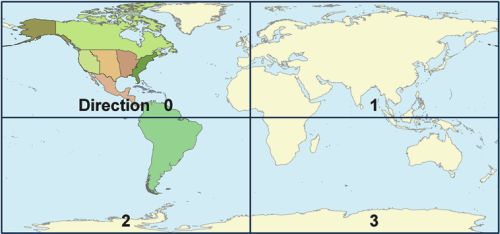
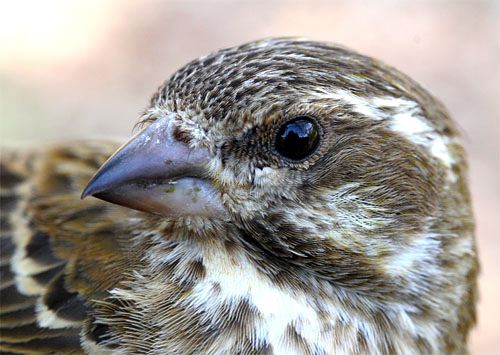
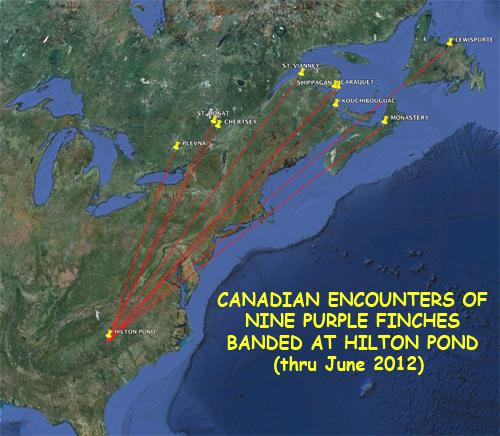
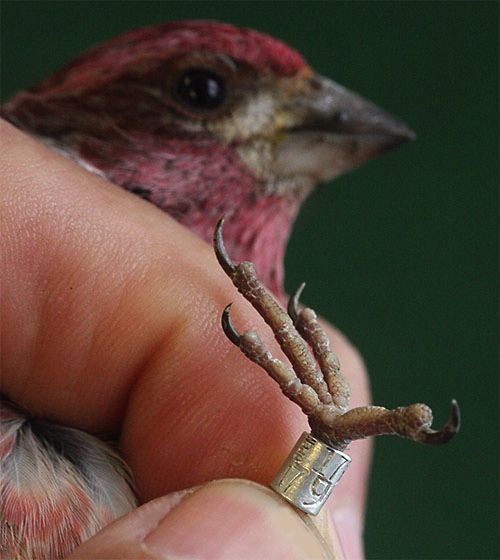
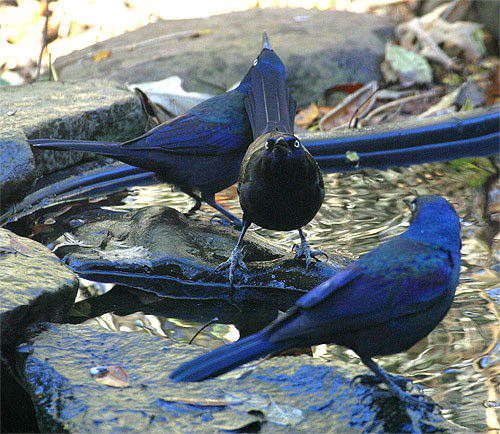
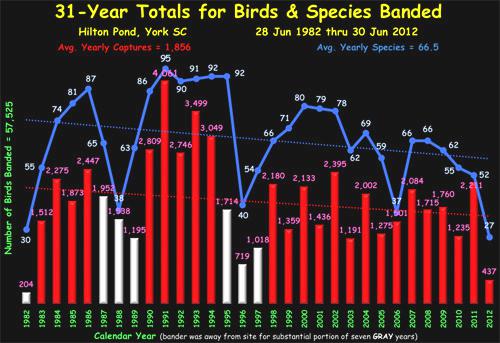
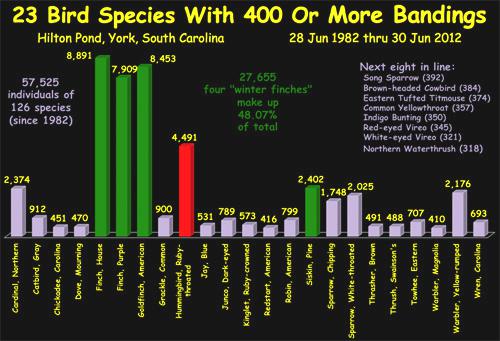
 and one of very few generating long-term data about birds within the ten-state Eastern Piedmont Region. By banding birds we've learned a great deal about avian distribution and abundance in the Piedmont, about site fidelity and migration, and about bird longevity--among other things. We've had a good run that has been rewarding and fun, and we hope you've enjoyed and learned from our efforts since 2001 as we've written about banding on-line through "This Week at Hilton Pond." Please allow us to further share our pleasure as we observe the Center's sparkling 30th anniversary in 2012.
and one of very few generating long-term data about birds within the ten-state Eastern Piedmont Region. By banding birds we've learned a great deal about avian distribution and abundance in the Piedmont, about site fidelity and migration, and about bird longevity--among other things. We've had a good run that has been rewarding and fun, and we hope you've enjoyed and learned from our efforts since 2001 as we've written about banding on-line through "This Week at Hilton Pond." Please allow us to further share our pleasure as we observe the Center's sparkling 30th anniversary in 2012. 

 Please report your sightings of
Please report your sightings of